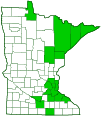peatland sheet-web weaver
(Hypselistes florens)
Conservation • Description • Habitat • Biology • Distribution • Taxonomy
Conservation Status |
|
|||||||
| IUCN Red List | not listed |
|||||||
| NatureServe | NNR - Unranked |
|||||||
| Minnesota | not listed |
|||||||
Description |
||
Peatland sheet-web weaver is a very small eight-eyed spider. It occurs across northern United States and Canada. Though very common, splendid dwarf spider is rarely seen. It spends its time under dead leaves, rocks, or other debris. It is often collected in large numbers in sweep nets. The male and female are similar in shape and color. The female is 1 ⁄16″ to ⅛″ (2.5 to 3 mm) long, the male a little smaller, 1 ⁄16″ (2.3 to 2.5 mm) long. The front part of the body (cephalothorax) may be bright orange, reddish-orange, or orangish-red. It is about as wide as long, rounded on the sides, and slightly constricted at the base. On the female it is relatively flat when viewed from the side. On the male there is a very high lobe near the front that bears the front middle eyes (anterior median eyes, or AME). The lobe is somewhat lighter in color than the rest of the cephalothorax. The remaining six eyes are arranged in a lower, slightly curved row of three closely-spaced pairs of eyes. On the male, there is a pit (cephalic pit) in a groove just behind each pair of posterior lateral eyes. The abdomen is dark gray to nearly black, spherical, and shiny. The legs are medium-length and are armed with spines. The first three segments of each leg (coxa, trochanter, and femur) are always bright orange, regardless of the color of the cephalothorax. The remaining segments dark gray with orange usually “showing through” to some extent. They may appear mostly orange, equally orange and dark gray, mostly dark gray, or entirely dark gray, but they are never entirely orange. |
||
Size |
||
Female Body Length: 1 ⁄16″ to ⅛″ (2.5 to 3 mm) Male Body Length: 1 ⁄16″ (2.3 to 2.5 mm) Legspan: 3 ⁄16″ to ¼″ (5 to 6 mm) |
||
Similar Species |
||
Habitat |
||
|
||
Biology |
||
Season |
||
April through August |
||
Behavior |
||
Spiderlings disperse in the fall by “ballooning”. They climb a branch, blade of grass, or fencepost, and release a long thread of silk. The silk thread catches the wind or even a light breeze and the spiderling floats to a new site. |
||
Life Cycle |
||
|
||
Food |
||
|
||
Distribution |
||||
|
Sources 24, 29, 30, 82. |
|||
| 10/15/2022 | ||||
Occurrence |
||||
Very common |
||||
Taxonomy |
|||
Class |
Arachnida (arachnids) |
||
Order |
|||
Suborder |
Araneomorphae (typical spiders) |
||
Infraorder |
Entelegynae |
||
Superfamily |
Araneoidea (orbweavers and allies) |
||
Epifamily |
Linyphioidea (dwarf, sheetweb, and hammock-web spiders) |
||
Family |
Linyphiidae (sheetweb and dwarf weavers) |
||
Subfamily |
Erigoninae (dwarf spiders) |
||
Genus |
Hypselistes |
||
Subordinate Taxa |
|||
peatland sheet-web weaver (Hypselistes florens bulbiceps) peatland sheet-web weaver (Hypselistes florens florens) |
|||
Synonyms |
|||
|
|||
Common Names |
|||
peatland sheet-web weaver |
|||
Glossary
Cephalothorax
The front part of a spider’s body, composed of the head region and the thoracic area fused together. Eyes, legs, and antennae are attached to this part.
Visitor Photos |
|||||
Share your photo of this arachnid. |
|||||
| This button not working for you? Simply email us at info@MinnesotaSeasons.com. Attach one or more photos and, if you like, a caption. |
|||||
Babette Kis |
|||||
Hypselistes florens, black and red splendid dwarf spider, on goldenrod Hypselistes florens, black and red splendid dwarf spider, on Canada goldenrod. Photos were taken Sept. 19, 2020 at Barnes Prairie, Racine Co., WI. |
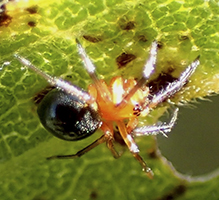 |
||||
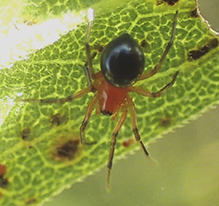 |
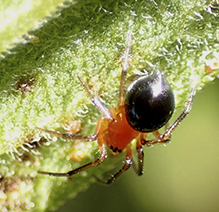 |
||||
Alfredo Colon |
|||||
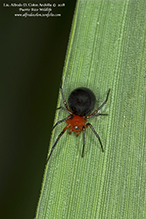 |
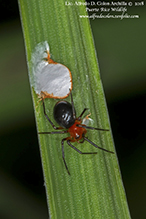 |
||||
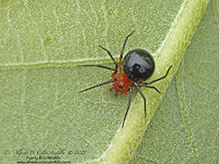 |
|||||
MinnesotaSeasons.com Photos |
|||||
|
|||||

Slideshows |
||

Visitor Videos |
|||
Share your video of this arachnid. |
|||
| This button not working for you? Simply email us at info@MinnesotaSeasons.com. Attach a video, a YouTube link, or a cloud storage link. |
|||
Other Videos |
|||
Splendid Dwarf Spider (Linyphiidae: Hypselistes florens) Belaying |
|||
About
Published on Oct 15, 2011 Photographed at Grand Forks, North Dakota (14 October 2011). |
|||


Created: 4/26/2019
Last Updated:
